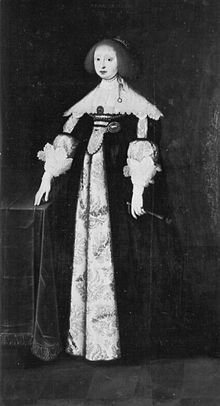Maria Elisabeth of Saxony (1610–1684)
Maria Elisabeth of Saxony (born November 22, 1610 in Dresden , † October 24, 1684 in Husum ) was a Saxon princess from the house of the Albertine Wettins , by marriage to the Duchess of Schleswig-Holstein-Gottorp .
Life
Marie Elisabeth was the second daughter of the Saxon Elector Johann Georg I (1585-1656) and his second wife Princess Magdalena Sibylle of Prussia (1586-1659), daughter of Duke Albrecht Friedrich of Prussia from the House of Hohenzollern and his wife Princess Maria Eleonore from Jülich-Kleve, born.
On February 21, 1630 Maria Elisabeth married Duke Friedrich III in Dresden . von Schleswig-Holstein-Gottorf (1597–1659), son of Duke Johann Adolf and his wife Princess Augusta of Denmark, daughter of the Danish and Norwegian King Friedrich II of the Oldenburg family . The couple had got engaged in Dresden three and a half years earlier. The marriage project was driven by the Danish Queen Sophie and the widow Electress Hedwig . Friedrich III. was at that time on the side of Denmark in the Lower Saxon-Danish War , while Saxony, although not active in this war, was on the side of the hostile Austrian imperial family. Maria Elisabeth's trousseau included some paintings by the painter Lucas Cranach the Elder, which was unusual for the time .
After the death of her husband, she retired to her Wittum Schloss Husum in 1660 , after having stood by her 18-year-old son Christian Albrecht for another year. She expanded this castle in the early baroque style and stood out as the patroness of art and culture. Husum experienced a heyday under Maria Elisabeth.
1664 was a full Bible in Schleswig print. The limited edition of no more than 100 copies of this so-called Maria Elisabeth Bible or Schleswig Bible (a Luther Bible with the text from 1545) enjoyed particular popularity. It mainly served the members and guests of the Husum court.
"Several copies got into the Protestant parishes of Schleswig-Holstein, as many churches in the country had been robbed of their books and especially their Bible due to the tiresome warfare ."
After the publication of the Luther Bible (1664) and the church book (1665), she initiated the publication of the Husum court hymn book from 1676. In 1684, Maria Elisabeth, the leading figure in intellectual and cultural life at the Husum court, died.
progeny
From the marriage with Duke Friedrich III. 16 children were born from Schleswig-Holstein-Gottorf:
- Sophie Auguste of Schleswig-Holstein-Gottorf (* 1630; † 1680); ⚭ 1649 Prince Johann von Anhalt (* 1621, † 1667)
- Magdalena Sibylla of Schleswig-Holstein-Gottorf (* 1631; † 1719); ⚭ 1654 Duke Gustav Adolf of Mecklenburg-Güstrow (* 1633, † 1695)
- Johann Adolf (* 1632, † 1633), Hereditary Prince
- Marie Elisabeth (* 1634; † 1665); ⚭ 1650 Ludwig VI. of Hessen-Darmstadt (* 1630; † 1678)
- Friedrich (* 1635; † 1654), Hereditary Prince
- Hedwig Eleonora of Schleswig-Holstein-Gottorf (* 1636; † 1715); ⚭ 1654 Karl X. Gustav of Sweden (* 1622; † 1660)
- Adolf August (* / † 1637)
- Johann Georg of Schleswig-Holstein-Gottorf (* 1638; † 1655), Hereditary Prince
- Anna Dorothea of Schleswig-Holstein-Gottorf (* 1640; † 1713)
- Christian Albrecht of Schleswig-Holstein-Gottorf (* 1641; † 1695), Duke of Gottorf and Prince-Bishop of Lübeck; ⚭ 1667 Friederike Amalie , daughter of King Friedrich III. of Denmark and Norway (* 1649; † 1704)
- Gustav Ulrich (* 1642; † 1642)
- Christine Sabine (* 1643; † 1644)
- August Friedrich von Schleswig-Holstein-Gottorf (* 1646; † 1705) 1666 Prince-Bishop of Lübeck; ⚭ 1676 Christine, daughter of Duke August von Sachsen-Weißenfels (* 1656; † 1698)
- Adolf (* 1647; † 1648)
- Elisabeth Sophie (* 1647; † 1647)
- Augusta Maria of Schleswig-Holstein-Gottorf (* 1649; † 1728); ⚭ 1670 Friedrich VII. Magnus (Baden-Durlach) (* 1647; † 1709)
ancestors
| Pedigree of Maria Elisabeth of Saxony | ||||||||
|---|---|---|---|---|---|---|---|---|
| Great-great-grandparents |
Duke |
King |
Elector |
Duke |
Margrave |
Prince |
Duke |
Emperor |
| Great grandparents |
Elector August of Saxony (1526–1586) |
Elector Johann Georg von Brandenburg (1525–1598) |
Duke Albrecht of Prussia (1490–1568) |
Duke Wilhelm V (1516–1592) |
||||
| Grandparents |
Elector Christian I of Saxony (1560–1591) |
Duke Albrecht Friedrich of Prussia (1553–1618) |
||||||
| parents |
Elector Johann Georg I of Saxony (1585–1656) |
|||||||
|
Maria Elisabeth of Saxony |
||||||||
literature
- Ute Essegern: Princesses at the court of the Electorate of Saxony , Leipziger Universitätsverlag, 2007, p. 365 ff. ( Digitized version )
- Otto FA Meinardus : On the Schleswig “Maria Elisabeth” Bible from 1664 , in: Contributions to the Schleswig City History , Issue 37, 1992, pp. 97-103.
- Ada Kadelbach : Das Husumer Hofgesangbuch (Schleswig 1676) - a hymn book and its sources believed to be lost , District Archives North Friesland 1983.
- Fritz Juntke : The Schleswig Bible from 1664 and its bindings , in: Gutenberg-Jahrbuch 1980, S. 316-324.
Web links
- Works by and about Maria Elisabeth of Saxony in the German Digital Library
- http://www.reisefuehrer-deutschland.de/schleswig-holstein/nordsee/husum/schloss-vor-husum.htm
- http://www.guide2womenleaders.com/womeninpower/Womeninpower1640.htm
Individual evidence
- ↑ Otto FA Meinardus: On the Schleswig "Maria Elisabeth" Bible from 1664 , in: Contributions to the Schleswig City History, Issue 37, 1992, pp. 97-103, here p. 97
| personal data | |
|---|---|
| SURNAME | Maria Elisabeth of Saxony |
| BRIEF DESCRIPTION | Duchess of Schleswig-Holstein-Gottorf |
| DATE OF BIRTH | November 22, 1610 |
| PLACE OF BIRTH | Dresden |
| DATE OF DEATH | October 24, 1684 |
| Place of death | Husum |

